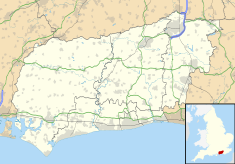The Old Town Hall is a municipal building in The High Street in Steyning, West Sussex, England. The building, which was used as a courthouse and a public events venue, is a Grade II listed building.[1]
| Old Town Hall | |
|---|---|
 Old Town Hall, Steyning | |
| Location | High Street, Steyning |
| Coordinates | 50°53′17″N 0°19′43″W / 50.8881°N 0.3285°W |
| Built | 1886 |
| Architect | Charles Dalby |
| Architectural style(s) | Neo-Georgian style |
Listed Building – Grade II | |
| Official name | 38, High Street |
| Designated | 9 May 1980 |
| Reference no. | 1027267 |
History
editThe first municipal building in the town was a market house in the middle of the High Street: it was located just outside the current No. 44 High Street and dated back at least to the 15th century.[2] It was arcaded on the ground floor, so that markets could be held, with an assembly room on the first floor. After it became very dilapidated and an obstruction to traffic, it was demolished in 1771.[2]
A second market house was built on a site previously occupied by a house owned by Sir John Honywood, 3rd Baronet; it was a timber framed structure completed in 1771.[2] Steyning had a very small electorate and two dominant patrons (Sir John Honywood and the Duke of Norfolk), which meant it was recognised by the UK Parliament as a rotten borough.[2] Its borough council, which had met in the market hall, was abolished and its right to elect members of parliament was removed by the Reform Act 1832.[3] A clock tower was added to the building in 1835.[4]
In the 1870s, a group of local businessmen led by a local landowner, Colonel Robert Ingram, decided to form a company to finance and commission a new municipal building, which was initially designated the "Steyning Public Hall and Assembly Rooms".[5][6] The new building was designed by a local architect, Charles Dalby, in the Neo-Georgian style, built by local builders, Messrs Chalcraft, in red brick at a cost of £791 and was completed in 1886.[1][7]
The design involved a symmetrical main frontage with three bays facing onto the High Street; the central bay contained a doorway with a stone surround; the outer bays on the ground floor were fenestrated by canted bay windows, while the first floor was fenestrated by casement windows. A panel with the inscription "Town Hall 1886" was installed above the doorway and the building was given a hip roof. Internally, the principal room was the assembly hall, which was intended for use as a courtroom for petty session hearings and as a public events venue for up to 400 people.[8]
West Sussex County Council acquired the town hall from the original development company in 1958 and erected modern courtrooms and prisoner cells to the rear of the town hall.[8][9] The complex continued to act as a venue for magistrates' court hearings until the courts service relocated in 1994.[10] The building was subsequently converted for commercial use and was subsequently occupied by a firm of estate agents.[11]
The building is accessible by the Steyning Clock Tower bus stop, which is served by Brighton & Hove bus routes 2 and 60.[12]
References
edit- ^ a b Historic England. "38, High Street (1027267)". National Heritage List for England. Retrieved 1 May 2022.
- ^ a b c d Pennington, Janet (2000). "The Market-Houses of Steyning". Sussex Archaeological Collections. Retrieved 1 May 2022.
- ^ "The History of Politics: The Rotten Boroughs of England". Julia Herdman Books. 21 April 2017. Retrieved 21 October 2019.
- ^ Historic England. "The Market House (1180415)". National Heritage List for England. Retrieved 1 May 2022.
- ^ "Steyning Heritage Trail" (PDF). Visit Steyning. Retrieved 1 May 2022.
- ^ Recknell, George Hugh (1965). Steyning, Sussex History and Descriptive Survey. Steyning Society. p. 23.
The property was built by Colonel Ingram (a once important family in Steyning) as a home for the magistrates (of whom he was Chairman) on the occasion of their meetings.
- ^ Tenders. The British Architect. 19 March 1886. p. ix. Retrieved 1 May 2022.
- ^ a b Baggs, A. P.; Currie, C. R. J.; Elrington, C. R.; Keeling, S. M.; Rowland, A. M. (1980). "'Steyning', in A History of the County of Sussex: Volume 6 Part 1, Bramber Rape (Southern Part), ed. T P Hudson". London: British History Online. pp. 220–226. Retrieved 1 May 2022.
- ^ "Steyning Historic Character Assessment Report" (PDF). West Sussex County Council. 1 August 2004. p. 17. Retrieved 1 May 2022.
- ^ "Steyning Justice through the Ages". Steyning Museum. Retrieved 1 May 2022.
- ^ "Hamilton Graham". On The Market. Retrieved 1 May 2022.
- ^ "Steyning Clock Tower (adj)". buses.co.uk. Retrieved 17 March 2024.
